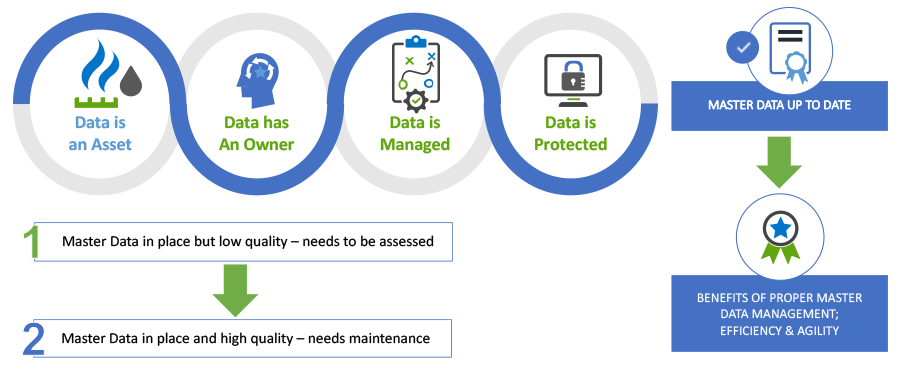

It is no secret that having a good quality of EAM master data in your system, regardless of the size of the company, is crucial. Master data is the backbone of the system and having a framework in place to manage it makes working with your system easier and more efficient. Data is all around us, but we do not always see it as an asset, nor have we the capability and understanding of how to really use it. Data can be turned into information, by defining its purpose and context. When having that in place, business processes can be linked to information, thus creating decisive knowledge and understanding of cause and effect. Harnessing this knowledge is key to fact-based decision-making and calls for governance.
So, how can you make sure that the master data in your system is of high quality, and more importantly, stays of high quality? There are different key principles which can be followed to make sure master data can be maintained and improved. This can be looked at from two scenarios:
- Master Data is in place but of low quality, so needs to be investigated.
- Master Data is in place and of high quality, but must be maintained and improved (an ongoing process).
If the master data within the system is not correct, it needs to be assessed. What is the as-is and what is the desired to-be? Being conscious about the state of data quality is the first step of defining the as-is. Linking it towards business goals – operational, tactical, or even strategic – is the next step and paves the way for creating a to-be scenario. Business value gives direction for the to-be state.
As soon as the master data is of high quality, it must be maintained. This consists of multiple aspects, like governance and mapping, but also grooming data processes, giving training for awareness and understanding, and creating placeholders of that knowledge via guidelines. Think for example what can happen if some asset, financial or other critical master data is not correctly in place? This can have negative effects on the business. For example, having business logic built into the system and having automated triggers in place, but introducing newly bought equipment with raw undefined data might cause the business logic and triggers to malfunction. But also think about the frustration of users who always need to spend (extra) time on finding or adjusting information in the system.
Some easy principles which can help in maintaining and improving the quality of master data are:
- Data is an asset – and must be treated accordingly.
- Data has an owner – each data object has an owner who is responsible for the quality.
- Data is managed – creation and adjustments are done in accordance with workflows.
- Data is protected – and can only be changed by those who are authorized.
When you are maintaining your master data by these four principles, a big step forward can be made. The benefits of proper Master Data Management can be harvested in analytics and reporting. This applies to the initial phase of data awareness when information can easily be re-used, and the system will become easier to maintain, with less time required for this task. Even more important, the organization can trust and build on the information in the system. Above and beyond this, in the domain of EAM, information will steer organizations towards automation, higher operational efficiency and ultimately driving competitive advantage in our digitalized world.

